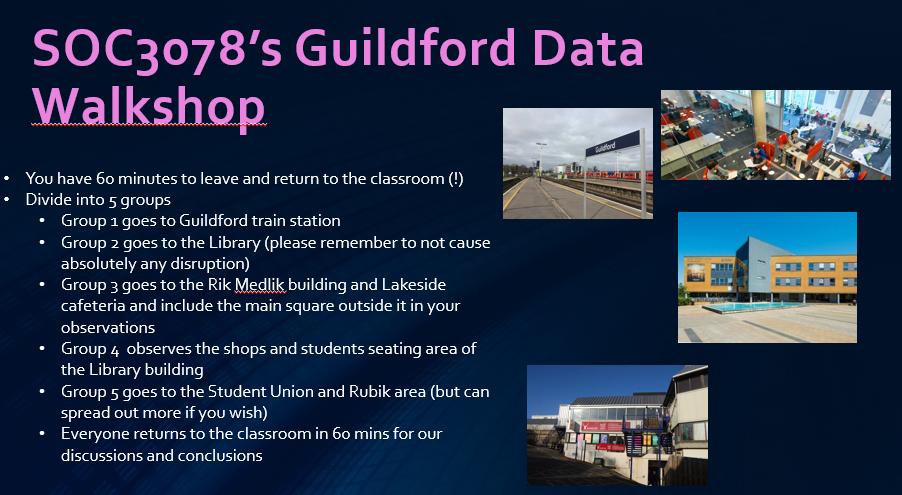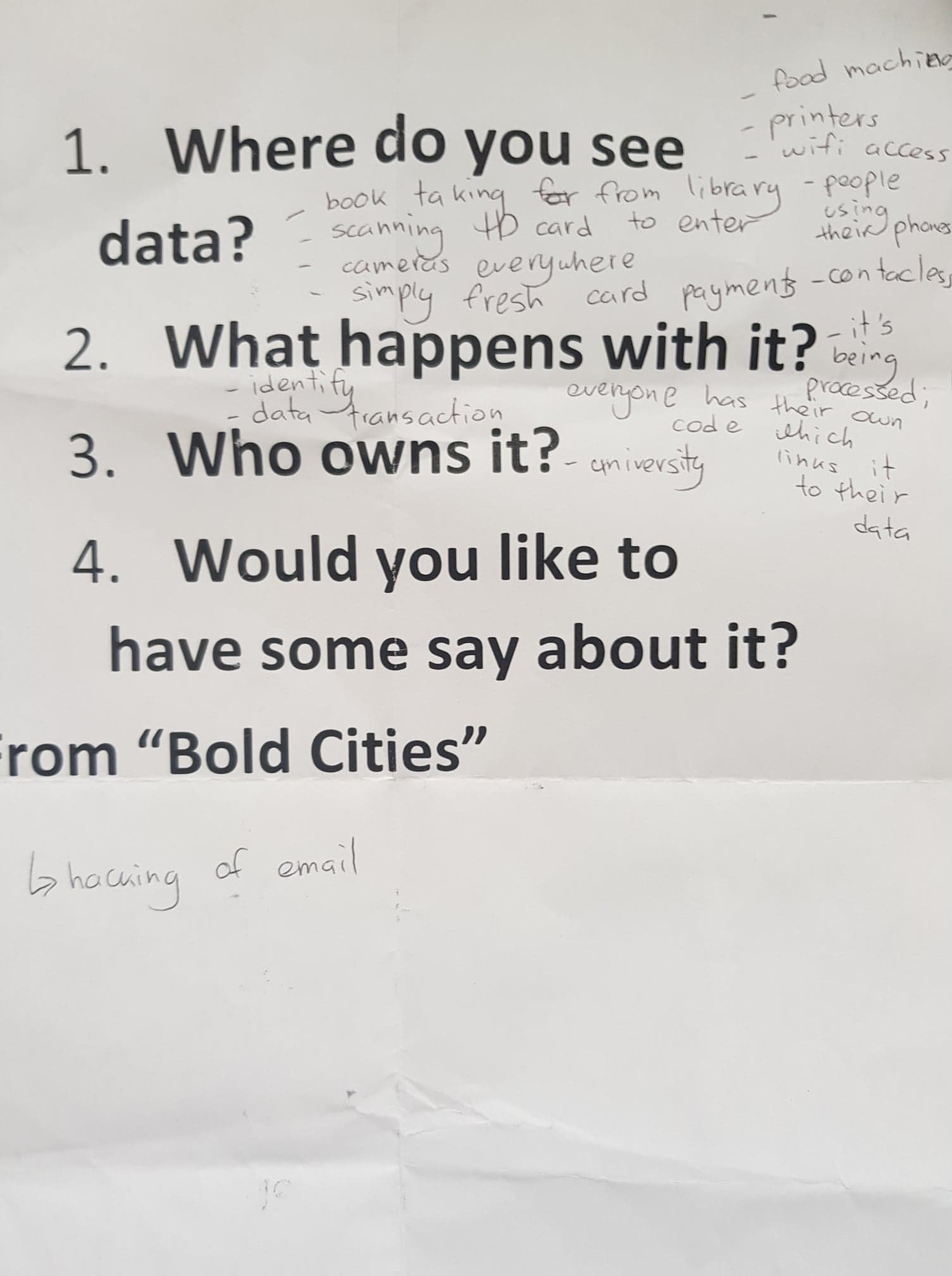By Ranjana Das with the students on SOC3078 – Data and the Digital in Platform Societies
Last week in Surrey Sociology saw final year students on SOC3078 – the Data and the Digital in Platform Societies module head out with pen and paper, in small groups, to do a ‘Data Walkshop’ – spotting data out and about in everyday spaces, and paying attention to how it is sought, provided and used, in often seemingly banal ways. We were inspired by Alison Powell’s excellent precedents of the data walkshop – and took as a starting point her blurb for a Data Walkshop she conducted in Cambridge. The brief that Powell and Taylor had set out for their walkshop was –
“Explore and discuss the data environment around the Cambridge Railway Station, including the site of Microsoft Research’s project on data and the residents of Tenison Road, through a process of rapid group ethnography. Arrive at 2.00pm sharp at the corner of Tenison Road and Station Road, in front of Microsoft Research, for a short introduction to the project. We will leave at 2:30pm for a 60 minute walk around the area, followed by discussion. We will reflect on the different conceptualizations of data that we discover on our walk and also on the disjunctions between conceptual and computational data. This will highlight that, underpinning any considerations of the ethics of big data, are particular understandings of what data is in the first place.”
With similar plans in mind we set ourselves the task of going to a variety of different spots in Guildford to consider the subtle and often unnoticeable ways in which the streets we walk on, the shops we shop at, the food we eat, the everyday life we live – is increasingly datafied. While the ideas I set out are suggested in the snapshot below, students selected their own venues and locales and came up with some fabulous notes.
One group said – “Myself, Tara and Alice went to Starbucks to observe the data collection going on around us, it was evident straight away that data was being collected in a variety of ways, for example, the till systems at the Starbucks counter, contactless payment, CCTV and access to the cloud through the public wifi. We discussed the different ways in which this data would be used, for example, via contactless payment Starbucks collect our bank information and our banks collect data on what, when and where we are making purchases. Signing into the public wifi also allows for huge amounts of data to be collected on us as it isn’t a secure network, including our location and the data stored in our cookies.
Overall, we thought the owner of the data would be shared in part between the University, Starbucks and our bank and in general, we did not feel that any of the data collected on us was unexpected. However, we did raise concerns over the amount of data able to be collected through the public wifi and the implications of an increasing reliance on contactless payment.”
Another group visited the library shop and foyer area and the library itself. They made hand-written notes. As per the second figure sent on by Vivian on behalf of her group – made a series of notes around everyday objects – food machines, printers, scanning machines, the Simply Fresh shop and the use of contactless cards which collate data on the purchases made – reflecting on the shift from cash to contactless.
Yet another group – Joe, Glenn, Simran, Stephanie, Beatrice, Franchesca and Sonia – also conducted their Data Walkshop in a Starbucks store. They considered “the ways in which we can create, observe and engage with data in an everyday setting. The process of payment is an area we can focus on as a point of data creation, as either using Apple Pay or contactless card payment generates a transaction history that goes beyond the physical act of tapping the card machine. This data is also collected by the Starbucks till; enlisting a history of purchases, the sums customers spend, the times of day that are the busiest, ‘peak’ periods or which items have been sold the most times. This can be used by Starbucks to inform decision-making processes, such as creating the staff rota and the ordering of stock. This illustrates to us that so many of the everyday acts we make are used to create data, and from there this data exists separately to ourselves and goes on a journey – to which we rarely know the end-point with any certainty. In our everyday lives we do not say “I consent to my actions being logged for you to create data and I am happy to not know where this data will end up”, but what we can see here is that our actions are saying this for us. This contributes to wider conceptualisations of data being ‘normalised’ and gradually immersed into everyday life.”
It was an engaging exercise and massively fruitful to head out of the classroom and look at everyday life. On returning after the 60 minute walkshop, nearly all groups noted the increasingly “natural” status of datafication and metrification in everyday lives, critiqued succinctly by Couldry &Mejias recently. They note – “The capture and processing of social data unfolds through a process we call data relations, which ensures the “natural” conversion of daily life into a data stream. The result is nothing less than a new social order, based on continuous tracking, and offering unprecedented new opportunities for social discrimination and behavioral influence”. That is precisely what we shall continue to look at as the weeks progress this autumn.
Please note: Blog entries reflect the personal views of contributors and are not moderated or edited before publication. However, we may make subsequent amendments to correct errors or inaccuracies.


